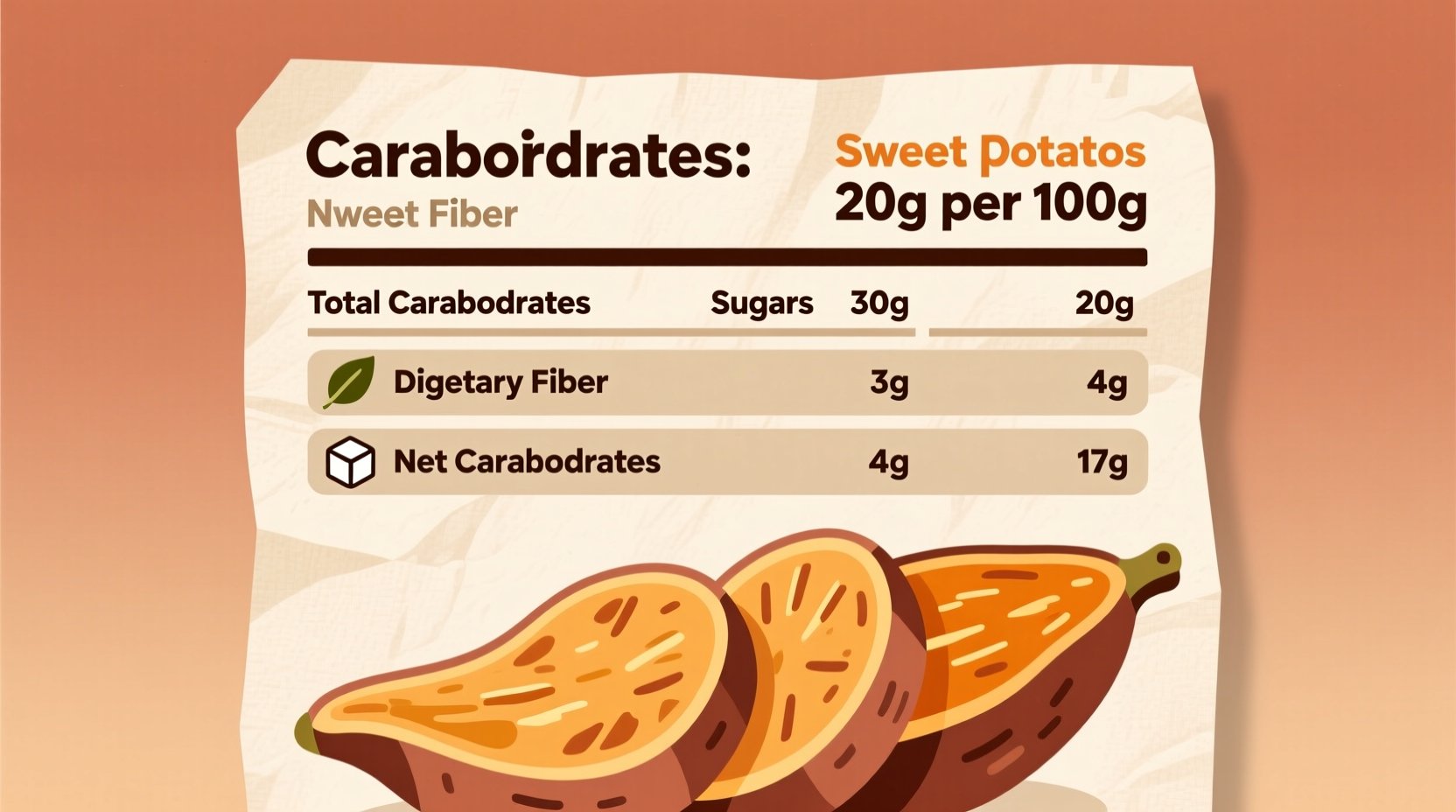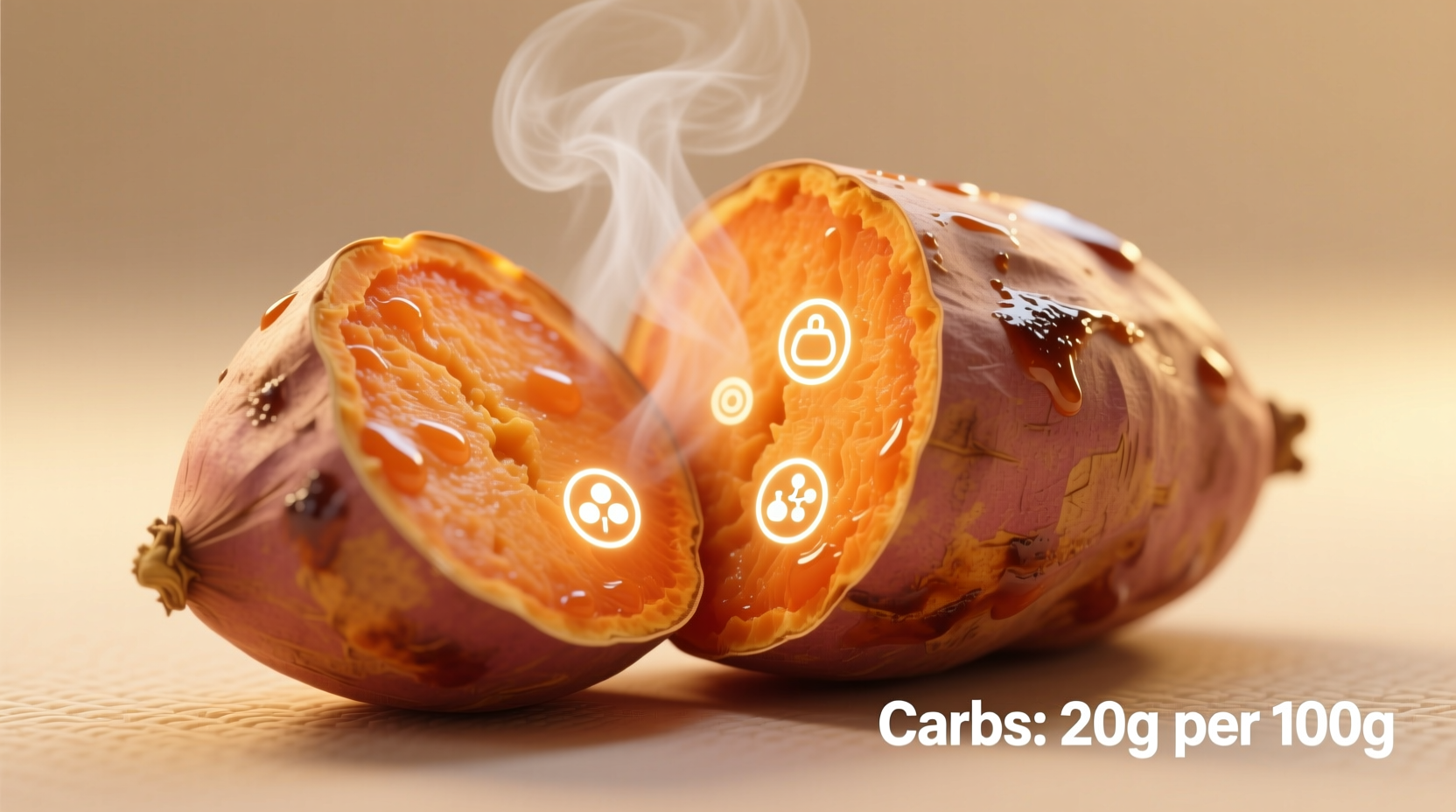Understanding the carbohydrate composition of sweet potatoes is essential for anyone managing their nutrition, whether for weight control, diabetes management, or athletic performance. Unlike simple carbohydrates that cause blood sugar spikes, sweet potatoes provide sustained energy through their unique blend of starches, fibers, and natural sugars.
Exact Carbohydrate Content: Breaking Down the Numbers
When evaluating carbs in a sweet potato, precise measurements matter. According to the USDA FoodData Central database, here's the detailed carbohydrate profile for different serving sizes:
| Serving Size | Total Carbs | Dietary Fiber | Sugars | hNet Carbs* |
|---|---|---|---|---|
| 100g raw | 20.1g | 3.0g | 4.2g | 17.1g |
| Medium (130g) | 27g | 4g | 7g | 23g |
| 1 cup mashed | 50g | 6.6g | 13g | 43.4g |
| 100g baked | 27.5g | 3.3g | 6.5g | 24.2g |
*Net carbs = total carbs minus fiber
This sweet potato carbohydrate breakdown reveals why they're nutritionally superior to many other starchy foods. The significant fiber content (about 15% of daily value per medium potato) slows carbohydrate absorption, preventing blood sugar spikes. Research published in the American Journal of Clinical Nutrition confirms that the resistant starch in sweet potatoes contributes to their favorable glycemic response compared to white potatoes.
How Cooking Methods Affect Carb Content
Many people wonder: does cooking change the carb count in sweet potatoes? The answer involves both concentration and transformation:
- Boiling: Retains most nutrients but may leach some water-soluble carbs into cooking water
- Baking/Roasting: Concentrates carbs slightly as moisture evaporates (increasing carb density per gram)
- Microwaving: Preserves the most nutrients with minimal carb alteration
- Steaming: Maintains carb composition closest to raw sweet potatoes
A study from the National Center for Biotechnology Information demonstrated that baking increases the glycemic index of sweet potatoes from 44 (boiled) to 63 (baked), though still significantly lower than white potatoes (78-111 depending on preparation). This sweet potato glycemic index comparison matters for blood sugar management.

Sweet Potato Carbs vs. Other Common Foods
Understanding where sweet potatoes fit in your diet requires comparison. Here's how they stack up against similar foods:
| Food (100g) | Total Carbs | Fiber | Glycemic Index | Notable Nutrients |
|---|---|---|---|---|
| Sweet Potato | 20.1g | 3.0g | 44-63 | Vitamin A (384% DV), Vitamin C, Potassium |
| White Potato | 17.5g | 2.2g | 78-111 | Vitamin C, Potassium, B6 |
| White Rice | 28.7g | 0.4g | 73 | Minimal micronutrients |
| Quinoa | 21.3g | 2.8g | 53 | Complete protein, Iron, Magnesium |
This carbohydrate comparison chart shows why sweet potatoes stand out. While they contain slightly more total carbs than white potatoes by weight, their higher fiber content, lower glycemic index, and exceptional micronutrient profile make them a superior choice for sustained energy. The American Diabetes Association specifically recommends sweet potatoes as a diabetes-friendly carbohydrate source due to their high fiber and complex carb structure.
Practical Applications: Using Sweet Potato Carbs Strategically
Knowing the carbs per sweet potato is just the beginning. Here's how to apply this information in real-world scenarios:
For Weight Management
The high fiber content in sweet potatoes promotes satiety. A medium sweet potato provides about 103 calories with substantial volume, making it an excellent choice for calorie-conscious eating. Pair with protein sources like chicken or fish to create balanced meals that prevent overeating.
For Blood Sugar Control
People managing diabetes should consider these evidence-based strategies:
- Choose boiled over baked sweet potatoes for lower glycemic impact
- Pair with healthy fats (like olive oil or avocado) to further slow glucose absorption
- Limit portions to ½ medium sweet potato (about 13g net carbs) when closely monitoring intake
- Always eat the skin, which contains additional fiber that moderates blood sugar response
The Academy of Nutrition and Dietetics confirms that sweet potatoes can be part of a diabetes-friendly diet when portion-controlled and prepared appropriately.
For Athletic Performance
Athletes benefit from sweet potatoes' complex carbohydrates for sustained energy. Consuming one medium sweet potato 2-3 hours before exercise provides ideal fueling. Post-workout, pair with protein for optimal recovery. Unlike simple carbs, the starches in sweet potatoes release energy gradually, supporting endurance activities.
Common Misconceptions About Sweet Potato Carbs
Several myths persist about sweet potato carbohydrates that deserve clarification:
"Sweet Potatoes Are Too High in Sugar for Diabetics"
While sweet potatoes contain natural sugars, their high fiber content and complex starch structure result in a moderate glycemic response. Research from the American Diabetes Association shows that when prepared properly (boiled with skin), sweet potatoes have minimal impact on blood glucose compared to many other carbohydrate sources.
"All Carbs in Sweet Potatoes Turn to Sugar in Your Body"
This oversimplification ignores the different types of carbohydrates. Sweet potatoes contain resistant starch (which doesn't fully break down into glucose) and fiber (which isn't digested at all). Only a portion of sweet potato carbs convert to blood sugar, and even then, the process occurs gradually.
"Sweet Potatoes Will Make You Gain Weight"
Weight gain depends on total calorie intake, not individual foods. Sweet potatoes provide substantial nutrients per calorie. A medium sweet potato contains just 103 calories but delivers over 400% of your daily vitamin A needs. When substituted for less nutritious carbs, they often support weight management rather than hinder it.
Maximizing Nutritional Benefits
To get the most from sweet potato carbohydrates:
- Eat the skin: Contains nearly half the fiber and additional nutrients
- Cool after cooking: Increases resistant starch content by 30-50%
- Pair with healthy fats: Enhances absorption of fat-soluble vitamins like vitamin A
- Avoid excessive added sugars: Marshmallow toppings or sugary glazes negate health benefits
The transformation of starches during cooking and cooling represents a fascinating sweet potato carb evolution process. When cooked sweet potatoes cool, some digestible starches convert to resistant starch through a process called retrogradation. This change makes the carbs less available for digestion, effectively reducing the net carb impact while increasing prebiotic fiber benefits.
Special Dietary Considerations
Different dietary approaches require specific considerations for sweet potato consumption:
Keto Dieters
While not keto-friendly in standard portions, creative approaches exist:
- Limited to 2-3 ounces (about 1/6 medium potato) for strict keto
- Choose Japanese sweet potatoes (satsumaimo), which have slightly lower carb content
- Track net carbs carefully (total carbs minus fiber)
Low-FODMAP Diets
Sweet potatoes are generally low-FODMAP in appropriate portions:
- Safe serving: ½ cup (75g) cooked
- Excessive portions may trigger symptoms in sensitive individuals
- Boiling may reduce certain FODMAPs compared to baking
General Healthy Eating
For most people, sweet potatoes offer an excellent carbohydrate source. The Harvard T.H. Chan School of Public Health recommends including them as part of a balanced diet 2-3 times weekly for optimal nutrient diversity.











 浙公网安备
33010002000092号
浙公网安备
33010002000092号 浙B2-20120091-4
浙B2-20120091-4